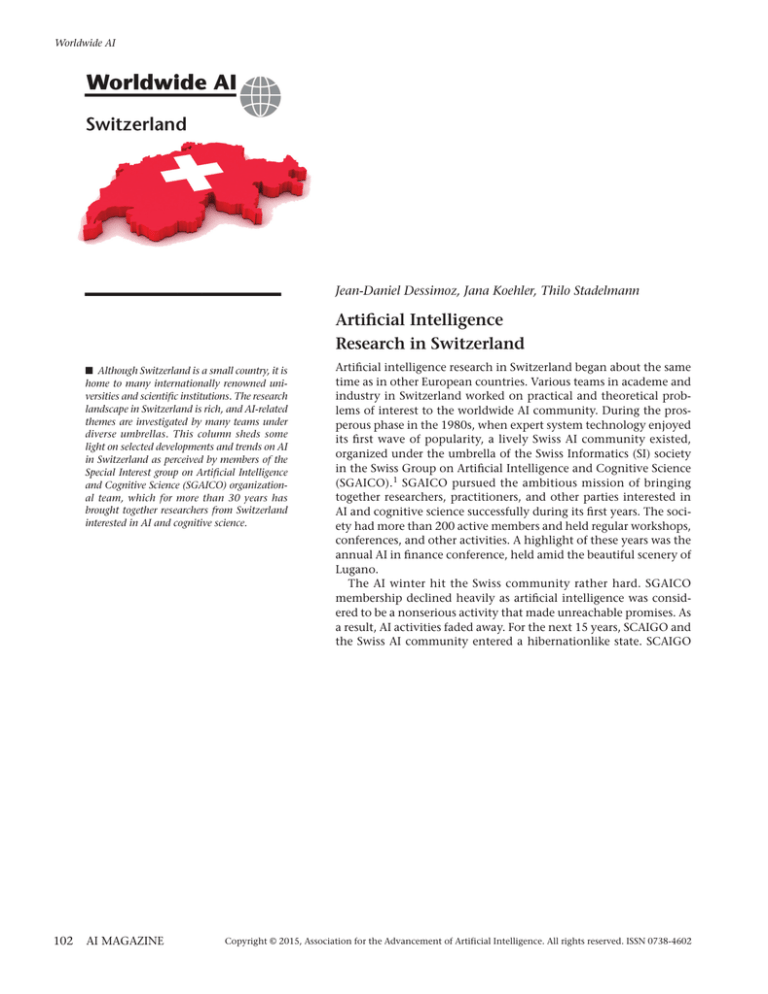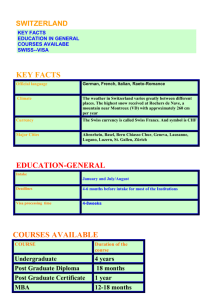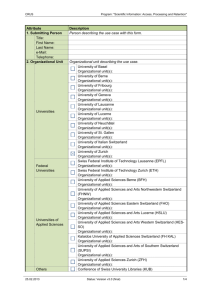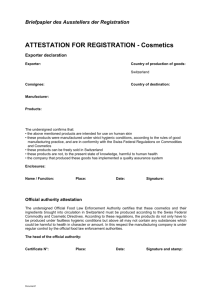
Worldwide AI
Jean-Daniel Dessimoz, Jana Koehler, Thilo Stadelmann
Artificial Intelligence
Research in Switzerland
I Although Switzerland is a small country, it is
home to many internationally renowned universities and scientific institutions. The research
landscape in Switzerland is rich, and AI-related
themes are investigated by many teams under
diverse umbrellas. This column sheds some
light on selected developments and trends on AI
in Switzerland as perceived by members of the
Special Interest group on Artificial Intelligence
and Cognitive Science (SGAICO) organizational team, which for more than 30 years has
brought together researchers from Switzerland
interested in AI and cognitive science.
102
AI MAGAZINE
Artificial intelligence research in Switzerland began about the same
time as in other European countries. Various teams in academe and
industry in Switzerland worked on practical and theoretical problems of interest to the worldwide AI community. During the prosperous phase in the 1980s, when expert system technology enjoyed
its first wave of popularity, a lively Swiss AI community existed,
organized under the umbrella of the Swiss Informatics (SI) society
in the Swiss Group on Artificial Intelligence and Cognitive Science
(SGAICO).1 SGAICO pursued the ambitious mission of bringing
together researchers, practitioners, and other parties interested in
AI and cognitive science successfully during its first years. The society had more than 200 active members and held regular workshops,
conferences, and other activities. A highlight of these years was the
annual AI in finance conference, held amid the beautiful scenery of
Lugano.
The AI winter hit the Swiss community rather hard. SGAICO
membership declined heavily as artificial intelligence was considered to be a nonserious activity that made unreachable promises. As
a result, AI activities faded away. For the next 15 years, SCAIGO and
the Swiss AI community entered a hibernationlike state. SCAIGO
Copyright © 2015, Association for the Advancement of Artificial Intelligence. All rights reserved. ISSN 0738-4602
Worldwide AI
membership declined to about 40 members and
most universities did not have an AI chair or offer
AI courses in their curricula. One notable exception was École Polytechnique Fédérale de Lausanne
(EPFL), where Boi Faltings and his team made significant contributions to the area of constraint
optimization. Other research groups would also
continue to work in areas such as robotics, computer linguistics, or search algorithms, but would
often not see themselves as part of the worldwide
AI community that gathers at conferences such as
AAAI, IJCAI, or ECAI.
The relative quietness of AI in Switzerland did
not prevent companies looking at AI technology as
a potential key driver for innovation. One example of this was Schindler, a worldwide maker of elevators. Schindler became interested in AI planning
after the first AI planning competition in 1998 and
soon after started to develop an AI-based control
algorithm for its products based on destination
control.2 Today, these algorithms are the most
sophisticated in the elevator market and made the
company’s destination-control products a huge
commercial and award-winning success. Many
other, smaller, technology-savvy companies and
startups enjoyed similar successes, all of which
have led to a growing need for AI specialists in
Swiss industry.
Current Lines of Research
With the recent AI-based technology successes,
interest in AI in Switzerland has resurged. In the
fall of 2012, the Swiss Informatics Society put
SGAICO under direct guidance of the SI president
to prevent the closure of this special interest group.
A diverse team of researchers was asked to help
revive the group and a small amount of money was
granted to restart it. The organizing team included
researchers from the University of Basel, EPFL Lausanne, and three universities of applied sciences in
Zurich, Lucerne, and Western Switzerland (HESSO), who brought in numerous academic and
industrial contacts. The team has launched several successful events and continues to bring energy
to the AI and cognitive science community.
SGAICO puts specific emphasis on joining contacts
between universities, applied research, and industrial applications and on reintegrating the AI and
cognitive science communities within the country,
where of course much remains to be done.
In the following paragraphs, we provide selected
pointers to groups in Switzerland that work in specific subfields of AI.
Planning, Scheduling,
and Constraint Reasoning
The areas of planning, scheduling, and constraint
solving are currently being studied at the Universi-
ty of Basel in the group led by Malte Helmert. A
team at Lucerne University of Applied Sciences has
a similar technology focus with a strong emphasis
on embedding these technologies into product
innovations for Swiss companies. Current projects
in Lucerne include control algorithms for major
Swiss players in the machine industry, applications
in medical diagnosis, forensics, and social welfare.
Machine Learning and Data Science
The Swiss IDSIA lab is a pioneer and major proponent of deep learning. Jürgen Schmidhuber’s team
at IDSIA recently won several prestigious patternrecognition competitions using deep neural architectures.3
ETH Zurich has appointed several chairs working in machine learning and, for example, organizes the Zurich Machine Learning and Data Science
Meetup, which easily attracts around 100 attendees for an evening of three technical lectures.
One possible explanation for the recent and very
strong interest in machine learning might be the
trend toward big data that has been widely recognized among industry and academic representatives alike. Much interdisciplinary work is done
under the headline of data science. For example,
the Datalab at the Zurich University of Applied Sciences is one of the first interdisciplinary groups in
Europe devoted to the creation of data products for
and with the industry. Recent results include medical applications, data-driven condition monitoring approaches, and specialized information
retrieval systems.4
Information Retrieval, Natural Language
Processing, and Computer Linguistics
A lively and internationally well-connected information retrieval community exists with notable
groups at the University of Geneva, the Universities of Applied Sciences of Western Switzerland
(HES-SO) and Zurich, the University of Neuchatel,
IDIAP (an Institute affiliated with EPFL), and the
Università della Svizzera italiana (USI). As an example, we mention the CLEF and ImageCLEF yearly
evaluation competitions,5 in which Henning
Müller and Martin Braschler are engaged.
Work in natural language processing and computer linguistics is also strong, in particular in
Zurich and the IDIAP institute. An interesting
application of natural language processing is, for
example, the paperless parliament in the Canton
of Valais, where all protocols are generated automatically based on algorithms developed at IDIAP.
Multiagent and |
Cognitive Systems, Robotics
Another subfield that has attracted both theoretical and practical research is multiagent systems.
There are several Swiss research teams, such as
SUMMER 2015 103
Worldwide AI
5% 5%
B.Sc.
45%
M.Sc.
Ph.D.
45%
Continuing Education
15%
20%
IR
AI
NLP
30%
35%
Other
Figure 1. Distribution of AI Courses.
Organized by degree program (left) and subdiscipline (right). Overall, 21
courses by 8 Swiss universities have been surveyed.
those at EPFL, the University of Fribourg (the
group of Beat Hirsbrunner) and HES-SO. Agent
technologies are broadly investigated including
interest in medical and social contexts, such as the
Commodity 12 project or the Computational
Social Science group of Dirk Helbing at ETH
Zurich.
For several decades, Rolf Pfeifer and his AI laboratory at the University of Zurich contributed to
various research themes in robotics. However,
upon Pfeifer’s recent retirement, the university
decided to discontinue robotics as one of its fields
of activity.
At ETH Zurich, the large Institute of Robotics
and Intelligent Systems has many activities, a
highlight of which are the flying robots developed
in the group of Raffaello D’Andrea (who is also a
cofounder of Kiva Robots).
At EPFL, we find robotics research across several
groups. Originally mostly addressing the industrial sector, the teams of Christof Burckhardt and
Frédéric de Coulon made contributions to
microtechnologies and signal processing, respec-
104
AI MAGAZINE
tively. Today, research has further diversified and
includes a broad range of industrial robotics as well
as biorobotics research.
Other robotics groups are active at the various
sites of HES-SO in Neuchâtel, Geneva, Fribourg,
Yverdon-les-Bains, and Sierre in the French-speaking part of Switzerland. These groups mostly focus
on industrial applications and contribute to robotics education initiatives. For example, the PIAGET
platform6 successfully participates in international
robotic competitions.
A special phenomenon of the Swiss research
scene is the connection of technically oriented
subfields of AI such as robotics and computer
vision to the electrical and mechanical engineering departments at Swiss universities. This leads on
the one hand to a very thorough investigation of
robotics technology within the electrical and
mechanical engineering communities, but on the
other hand also causes a partial disconnect to other methods developed in AI and computer science,
making areas such as cognitive robotics follow different development paths in Switzerland when
compared to other countries.
Finally we want to draw attention to the Blue
Brain project — an FET flagship project of the European Union that is led by the team of Henry
Markram at EPFL. The ultimate goal of the Blue
Brain Project is to reverse engineer the mammalian
brain. To do so, the project combines many disciplines around a neuroscience and cognitive science
core to develop models of the human brain that
can be used for simulation and for example to
understand the mechanisms behind diseases such
as Alzheimer’s.
AI Education
Recently, several Swiss universities appointed professors with an AI background and added AI-related lectures to their curricula, such as the Universities of Basel and Zurich and ETH Zurich, which
focus strongly on machine learning. Last year,
SGAICO conducted a survey on AI education in
Switzerland, which showed an impressive increase
and richness of AI-related courses at Swiss universities (figure 1).
At the bachelor and master’s level, various courses are taught in classical AI, information retrieval,
natural language processing, and other subdisciplines, notably robotics. Additionally, two complete programs exist that specialize in an M.Sc. in
AI and a professional education diploma in data science. However, the survey also illustrated that
the community was split. No courses from computer vision, machine learning, or data mining
were submitted to this survey. Although such
courses exist at many universities, they are not considered to be part of the AI community and field.
Robotics plays an important role in education
Worldwide AI
and often serves as a means to attract young people to technical subject fields and computer science. However, no robotics courses were submitted
to our survey as these are not considered as part of
AI. Robotics is an excellent domain for education
purposes for at least three complementary reasons.
First, there is the richness in number and diversity
of technical components involved. Second, to succeed in building a robotic system, a natural form of
teamwork is necessary. Finally, robots ground cognition in the real, physical world and they act in
this world and thereby interact with human
beings.
Robot-CH is an association that promotes robotics in Switzerland. It has been leading initiatives in
robotic competitions and in robotic education for
more than 10 years. For example, Bricobot is an
example of an elementary platform for robotic education that has been developed in Switzerland.
Swiss teams also participate in international competitions such as for example the FIRST Lego
League, Eurobot, or RoboCup at Home. The International Conference on Robotics in Education was
also held in May at Yverdon-les-Bains in Switzerland.7
For More Information
This short column highlights a few of the numerous activities in AI-related research that are conducted in Switzerland. With the diversity of the
field and the rich research landscape in Switzerland
in general, we cannot be complete, but we hope to
have provided the interested reader with initial
pointers into Swiss research. Beyond this article,
we would like to invite international AI researchers
to contact SGAICO when traveling to Switzerland. We can establish contacts to AI/CO
researchers and we offer the SGAICO Forum lecture
series, where we can organize or announce your
talk given at a specific Swiss institution to the
nationwide SI communities spanning several thousand members.
Acknowledgement
We would like to thank René Schuhmann and Boi
Faltings for valuable input and comments on a
draft of this article.
Notes
1. The SI is one of the major IT/computer science organizations in Switzerland. The homepage of SI and SGAICO
can be found at www.s-i.ch/fachgruppen-und-sektionen/sgaico.
2. For more information, see the 2002 article by J.
Koehler and D. Ottiger: An AI-Based Approach to Destination Control in Elevators, AI Magazine 23(3): 59–78.
3. See the 2015 paper by J. Schmidhuber. Deep Learning
in Neural Networks: An Overview. Neural Networks, Vol-
ume 61( January 2015): 85–117.
4. See, for example, the 2014 paper by K. Stockinger and
T. Stadelmann. 2014. Data Science für Lehre, Forschung
und Praxis. HMD — Praxis der Wirtschaftsinformatik,
Springer Fachmedien Wiesbaden 51(4) (August 2014): 469–
476.
5. See the 2010 paper by H. Müller, P. Clough, Th. Deselaers, and B. Caputo. 2010. ImageCLEF — Experimental
Evaluation in Visual Information Retrieval. Springer Information Retrieval Series, Vol. 32. Berlin: Springer.
6. See the 2013 paper by Hayato Omori, Jean-Daniel
Dessimoz, Hiroki Tomori, Taro Nakamura, and Hisashi
Osumi. Piaget for the Smart Control of Complex Robotized Applications in Industry. ICINCO (2) 2013: 528–535.
7. rie2015.org/.
Jean-Daniel Dessimoz is a professor of robotics and
automation at the University of Applied Sciences and
Arts of Western Switzerland, Yverdon-les-Bains, Switzerland.
Jana Koehler is a professor of computer science at the
University of Applied Sciences and Arts in Lucerne,
Switzerland.
Thilo Stadelmann is an associate professor at the Zurich
University of Applied Sciences, Institute of Applied Information Technology in Switzerland.
SUMMER 2015 105




